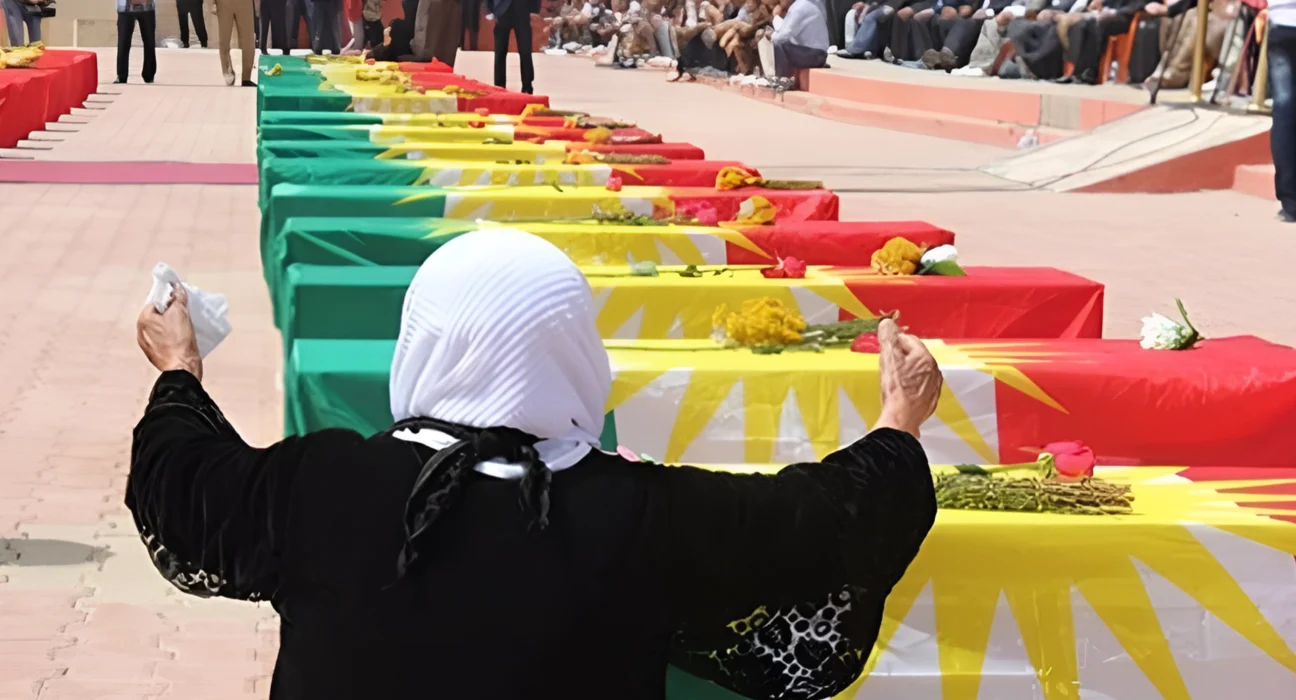The Anfal Genocide, which took place in 1988, was a series of campaigns carried out by the Iraqi Ba’ath regime under the leadership of Saddam Hussein. It was specifically targeted against the Kurdish population in Iraq. The Anfal campaigns in eight phases lasted from February to September 1988 and resulted in the systematic mass murder, disappearance, and displacement of thousands of Kurds.
During the Anfal genocide, the Iraqi regime implemented a strategy to destroy the Kurdish people and their identity. This included widespread attacks on Kurdish villages, chemical weapons, mass killings, and forced displacements. Thousands of Kurdish civilians, including men, women, and children, old and young, were brutally executed or subjected to torture and forced disappearances.
The Anfal genocide resulted in the destruction of numerous Kurdish communities, displacement of populations, and loss of countless lives. It is estimated that 182 thousands of Kurds were Genocide during these campaigns.
Anfal is the eighth surah of the Qur’an, which means booty from the infidels in war. The Ba’ath regime used this name for its military operation, Operation Anfal, which took place. The extermination of the Kurdish people was the culmination of the crimes committed by the Iraqi state during the Ba’ath regime. Before Operation Anfal, the Ba’ath regime had developed and implemented significant programs and plans, including:
The decision to conduct a general census of Iraq in 1987 to collect comprehensive information on the population of Iraq in general, with particular attention to Kurdistan.
Issuance of the decision of the Revolutionary Leadership Council granting absolute powers to Ali Hassan al-Majid to mobilize and destroy all of them, such as decision No. 160 of March 29, 1987.
The decision of the commander of the Northern Organization Bureau, Ali Hassan al-Majid, to carry out the operation in a brutal and coercive manner, such as Decision No. 4008/28 of June 20, 1987.
All these measures, led by Iraqi President Saddam Hussein and the Ba’ath regime, were significant steps toward Genocide, which included:
identification
collection
destruction.
Decision No. 160 of the Revolutionary Leadership Council of 1987:
Under Decree 160 of 1987, Saddam Hussein appointed Ali Hassan al-Majid as head of the Northern Organization Office, giving him full authority to implement leadership objectives throughout the northern region, including Kurdistan, to maintain security, peace, and stability.
Northern Organization Bureau Leadership Decision No. 28/4008 (1987):
After assuming office as head of the Northern Organization Office, Ali Hassan al-Majid immediately issued Order No. 28/4008 on June 20, 1987. This order was directed to the Iraqi army corps (1, 2, 5).
It is known as the manifesto of Genocide against the Kurdish people. The decision consisted of seven points, including the establishment of security-restricted areas (“المناطق المحظورة أمنيا”) and set June 22 as the deadline for implementation.
- The decision strictly prohibits the presence of humans and animals in these areas and allows unlimited shooting.
- This decision also led to the forced relocation of village residents to the community,
- The security agencies will investigate anyone arrested in the security-restricted areas (Muharrama areas), and the death penalty will be imposed on people aged 15 to 70.
Stages of the Anfal campaign:
The Anfal campaign, carried out by the Iraqi regime through intelligence, security, military, and administrative plans, was known as Operation Anfal and lasted from February 22, 1988, to September 6, 1988. The stages of the campaign were as follows:
First Anfal: Attack on Sargalu and Bargalu areas from February 23 to March
Anfal II: Attack on Karadag and Jafayaty Valley from March 22 to April
Third Anfal: Attack on Garmian region from 7 to April 20.
Anfal IV: Attack on the Zey Bachuk Valley from May 3 to
Anfal 5, 6, and 7: Attacks on the valleys in the mountains of Shaqlawa and Ruandz from May 15 to August
The eighth or final Anfal: the attack on Badinan from August 25 to September 6, 1988.
During the Anfal campaigns, many villages were destroyed, and the population forcibly relocated.
Thousands of people, regardless of religion, gender, or age, including children, women, and older, were subjected to displacement, arrest, killing, and Disappearance. Many were shot, tortured, and buried in mass graves. Individuals were rounded up and died in detention camps and violent camps such as Tobzawa, Dubz, Nazarki, Nugrasalman, Salamiya, and Quratu, each with its own tragic story of crimes committed.
Various weapons, including internationally prohibited weapons, chemical weapons, and poison gas, were used during the Anfal campaigns. Government documents indicate that about 4,500 villages were burned, destroyed, flattened, and cleared.
During the Anfal campaigns, 182,000 civilians were massacred regardless of race, age, or religion. Their fate became apparent in mass graves after the fall of the Ba’ath regime.
The Iraqi regime’s strategy in the Anfal campaign against the Kurdish people was:
- Destruction of the Kurdish nation and extermination of the Kurdish population.
- Suppression of Kurdish political and armed resistance.
- Destruction of Kurdistan’s economic infrastructure and paralysis.
- Changing the geographical and demographic characteristics of Kurdistan.
- Implementing Arabization policies in Kurdish areas. (Arabization, Ba’athistization, displacement).
The goals of the Iraqi regime in Anfal Kurdish women:
- Creating mental distress by separating men and women, especially young people.
- Violation of women’s morality and dignity.
- Restore the system of slavery, which includes the buying and selling of women as enslaved people.
- Human rights violations.
- Disruption of family structure.
The Anfal campaign lasted six months and 14 days, began on February 23, 1988, and ended on September 6, 1988. Still, its social and psychological impact on society and the victims’ families are constantly felt.
The Anfal case:
After the fall of the Ba’ath regime in 2003, the Anfal case was brought before the Iraqi High Criminal Court in 2006. In 2007, a genocide verdict was declared by the court, recognizing the gravity of the crimes committed during the Anfal campaigns.
This verdict was later approved by the Iraqi parliament and the federal government, further solidifying the recognition of the Genocide. However, despite these legal acknowledgments, the issue of material and moral compensation for the victims and survivors of the Anfal genocide has remained unresolved.
The Iraqi government’s lack of action or silence regarding compensation for the victims is a matter of concern. The government needs to address the balance issue and support the affected individuals and communities who have suffered immense loss and trauma due to the Anfal genocide.
Efforts should be made to ensure justice, reparations, and meaningful support for the survivors and their families, allowing them to rebuild their lives and heal from the deep wounds inflicted upon them.
“Regarding the recognition of the Anfal genocide, some countries of the international community have acknowledged it as a crime of Genocide and against humanity. Although efforts have been made to document and investigate the crimes committed during this period, more efforts are still needed.”
“Remembering and acknowledging the Anfal genocide is crucial to honor the victims, provide justice to the survivors, and ensure that such heinous crimes are not repeated.”

